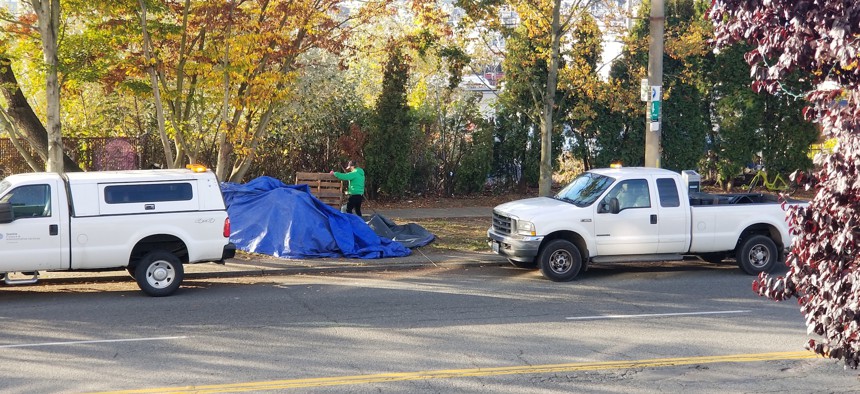Snapshots of America’s Homelessness Crisis in 4 Cities

A city work crew in Seattle clears a homeless camp along NW Market Street in the Ballard neighborhood on Thursday morning. Michael Grass / Route Fifty
From Seattle to Akron to Los Angeles and Minneapolis, here’s how local leaders and others are trying to provide shelter—or deny shelter—to those who desperately need stable housing.
SEATTLE — Cigarette butts, batteries and minor debris are all that remains of a homeless encampment along a stretch of NW Market Street, part way between the Ballard neighborhood’s historic commercial core and the recently opened Nordic Museum. For the past few weeks, complaints proliferated about a handful of tents—and the collection of bicycles, trash and other collected clutter that grew with it—stretched out along a high-profile spot on a heavily-trafficked neighborhood thoroughfare.
The tents were the latest local homelessness flashpoint that played out on a neighborhood Facebook group and what the city was and wasn’t—going to do about it. With confidence in the city and police’s response pretty low among many Ballard residents, some recommended that victims of bicycle theft in the neighborhood check out the alleged “bike chop shop” at the Market Street camp.
“Hard working citizens have to take action in getting their own property back while the police do nothing, and these criminals keep running the show. It’s infuriating,” one Facebook commenter wrote in a recent post.
Thursday was the city’s deadline for the Market Street campers to clear out after numerous complaints were filed. And in the course of about two hours that morning, as Route Fifty observed from our West Coast bureau just down the street, the encampment was no more.
The removal of the tents along Market Street is, of course, just an example of treating the symptom of homelessness and not addressing its root causes—something that’s easier said than done in a city with such expensive housing and deep-seeded opposition to new housing in neighborhoods.
In a recent Seattle Times article, Councilmember Mike O’Brien noted the ongoing challenges the city faces with its response:
“We’re doing things and getting a lot of results, but we find ourselves overwhelmed by the problem,” O’Brien said. And despite data that he says shows the problem is improving, “people continue to feel like it’s getting worse.”
Homelessness in Ballard, located about seven miles northwest of downtown Seattle, has quadrupled over the course of one year.
Earlier this month, the King County government, which plays an important role in delivering social services in and around Seattle, announced that it would take the west wing of its downtown corrections center and turn it into a temporary emergency shelter for 125-150 single homeless adults.
“Throughout King County government, we are constantly asking: what resources can we leverage to help people off the streets?” King County Executive Dow Constantine said in an announcement. “What innovations can we deploy? What new approach can we try? These actions will help bring more people inside for the winter, and provide more outreach to those living on sidewalks, and in doorways, and parks.”
The new shelter is expected to open in December and will cost about $2 million a year to operate.
Here’s what’s happening in a few other U.S. cities ...
Akron, Ohio: Last week, the libertarian-leaning Institute for Justice is suing the city of Akron on behalf of a local property owner who has been told by local officials to stop allowing homeless people to camp on his property in the Middlebury neighborhood. “We want to bring together [property owner] Sage [Lewis] and the homeless residents and others and have a trial about the city’s decision to cast people back out into the streets and woods,” said Jeff Rowes, a senior attorney for the Institute for Justice at a press conference, according to the Akron Beacon Journal.

Los Angeles, California: Mayor Eric Garcetti’s plan to build new emergency shelters at different sites across the nation’s second-largest city met intense anger from residents in the Venice neighborhood during a town hall meeting on Thursday—though it should be noted that not everyone in the seaside community opposes the shelter plan. “The easy thing to do politically is to walk away,” Garcetti said, according to the Los Angeles Times. “We can’t afford to walk away from homelessness.”
Minneapolis, Minnesota: After the largest homeless encampment in Minnesota took shape this summer along Hiawatha Avenue southwest of downtown Minneapolis, Minneapolis Mayor Jacob Frey announced in September that the city had found a better site for the homeless families and individuals. Public health officials have been especially worried about the Hiawatha Avenue camp due to the presence of drug-resistant diseases like MRSA. With winter fast approaching in Minnesota, what’s happened since? On Friday, the Minneapolis City Council OK’d $1.5 million to relocate the Hiawatha camp, “though the type of temporary housing to be used and who will operate it remain undetermined,” according to the Star Tribune. The relocated camp site is owned by the Red Lake Nation.
Michael Grass is Executive Editor of Government Executive’s Route Fifty and is based in Seattle.
NEXT STORY: News Deserts Widen as Newspapers Shut Down






